Before his career as a producer and television personality, Adam Palmer was an alternative education teacher for his grade 7 to 12 students deemed ‘too tough to teach’. Adam never taught a film class or made a film, yet he launched a film class with a single book that changed their lives.
By Stavros C. Stavrides
- Alternative Education: Teaching the 'Tough To Teach'
- The Teacher as a Student
- Why a Film Class?
- Learn a Chapter, Teach a Lesson
- "Cyber Film School changed my life."
- Getting Started
- Class Film Project Trailer
- Equipment
- Project Based Learning with Community Involvement
- Diverse Learners
- Latest Edition
Alternative Education: Teaching the ‘Tough To Teach’
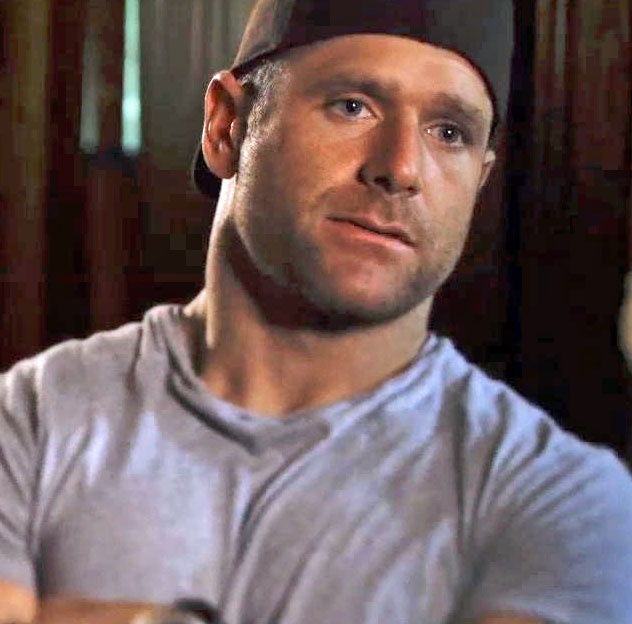
“At risk? I’m not a fan of that term. All youth are vulnerable at some point, to some degree.”
~Adam Palmer
The Teacher as a Student
In 2016, Adam Palmer rans a youth inclusion program at a First Nations community school in Agassiz, British Columbia, ninety minutes west of Vancouver.
That is where the youth counsellor and teacher integrated his Alternative Education class into the high school environment at STS’Ailes (‘Chehalis’) First Nations community, where his students work at their own pace within the school’s mainstream curriculum. Adam’s job is to keep them in school and out of the hands of the authorities.
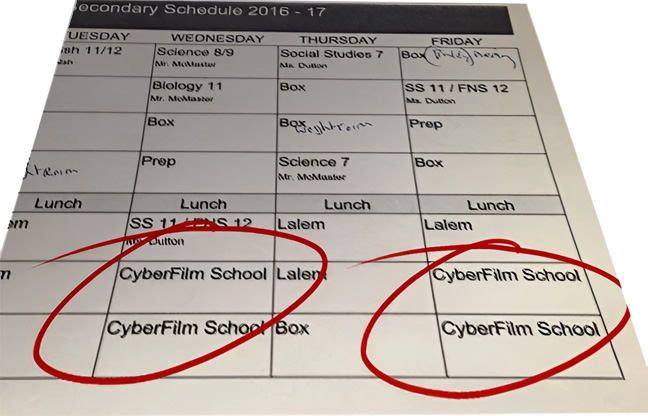
Further, Adam works alongside English teacher Kevin Walsh, who offers extra marks for the script portion of the film program in support of the school’s curriculum. The school’s IT officer Mark Balfour admits, “Some of these kids are tough as nails.”
Why a Film Class?
‘Alternative Education’ was never a term that came to Adam’s mind before this. Additionally, neither Adam nor English teacher Kevin had ever taught film. Yet their passion for the wellness of these students ended up as just one model that represents the term.
Adam began classes here as an Outdoor and Wilderness Education Teacher, involving his students in rigorous outdoor activities to foster land-based knowledge, teamwork, a sense of achievement, and self-worth.
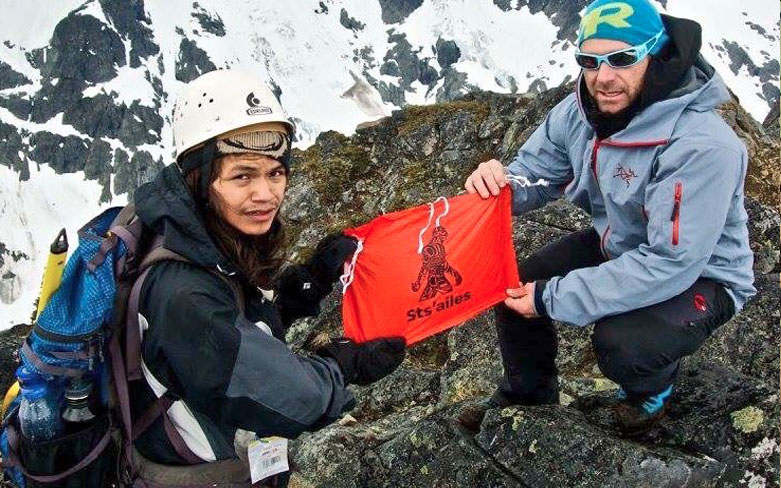
“But not all of these kids are built for climbing and caving,” he admits. “There are the creative ones – the thinkers and the reflective among the bunch who would rather observe the doers. Getting them to participate was a bit of a push.”
However, on a wilderness expedition, Adam noticed a common thread that bound the group, despite their differences. The students took snapshots, recorded videos, and shared equally with each other, all enjoying a common interest, even if for moments at a time.
Learn a Chapter, Teach a Lesson
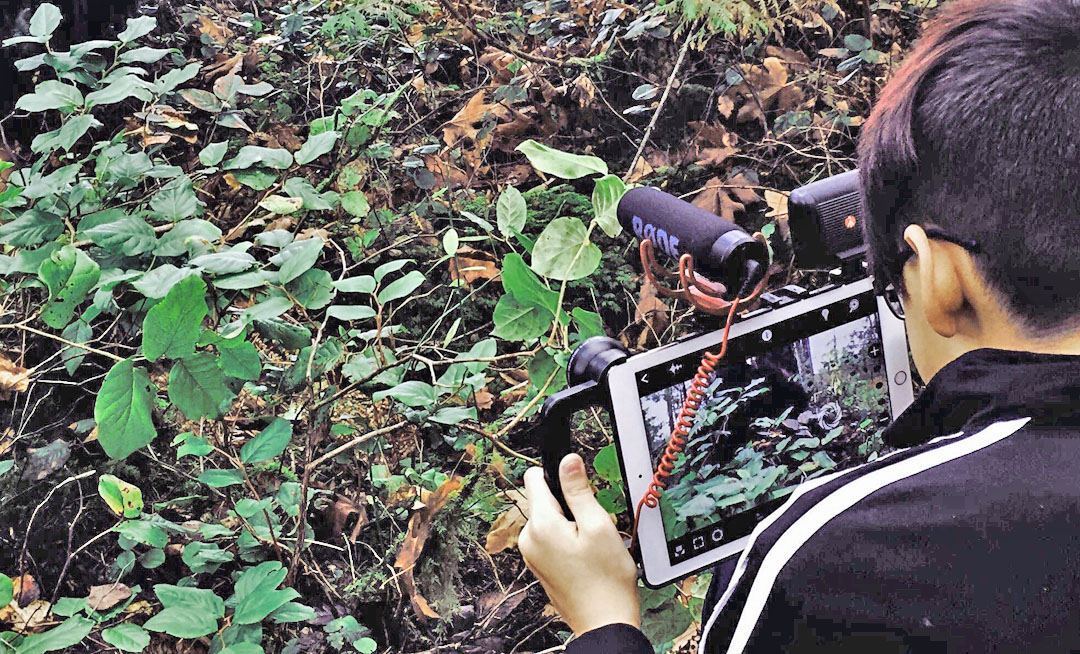

Formerly, Adam’s only filmmaking experience was as a video enthusiast, having produced a class video project in the past. “It was a lot of home-movie point-and-shoot stuff,” he admits. Not much film craft to it, and it didn’t get screened much. But it did bind the group in a new way.”
Soon after backed by little more than his passion for the subject and the eagerness of his students, Adam gave me a call.
“I want to start a film course at my school,” he said. “Can I use your program to do this?”
If you do this in earnest, you will learn to ‘speak’ a new language – a visual language of film, and so will your students.”
“Of course”, I replied confidently, even though we were still in its experimental phase. “But you’ll need to follow each chapter and do the exercises. If you do this in earnest, you will learn to ‘speak’ a new language – a visual language of film, and so will your students.”
Adam was a student as well as a teacher.
“Cyber Film School changed my life.”
Matthew, 14years old
Testimonial Video (3 minutes):
Getting Started
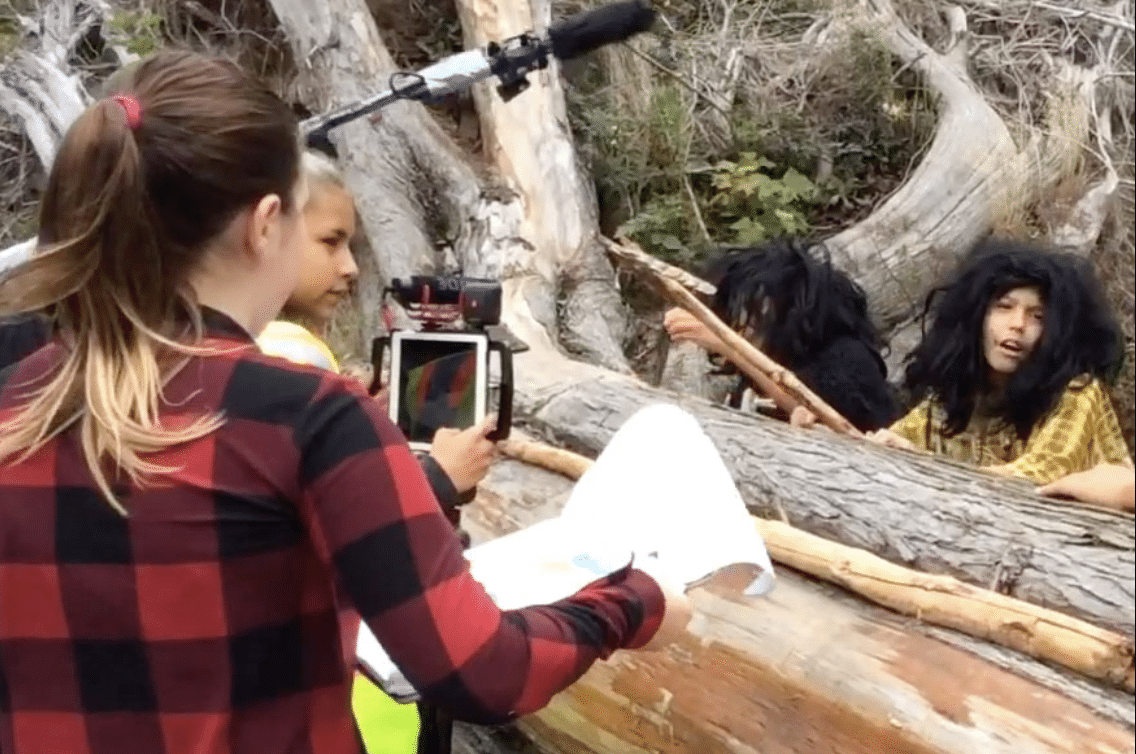
Adam was already thinking of the capital outlay he would need to start a film course for his high school students.
“Does your school have iPads or Macs?” I asked.
“Yes,” he replied.
“Then you’re ready.”
The topics and exercises are generally structured in the manner of first-year film schools, where film language encompasses history, applied visual literacy, and the theory of the craft, with the beginner filmmaker in mind.
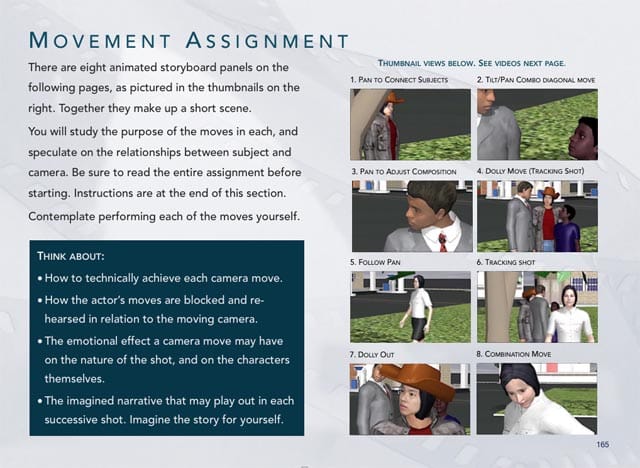
The user/reader is thus freed up to learn, practice, and apply the very core of film language right on the iPad or iPhone.
Although every chapter of this multi-touch textbook has exercises and assignments that can be shot, edited, and shared on just one device, A Mac computer and conventional camera enhance the experience.
For himself, Adam downloaded his copy through Apple Books using his Apple ID. Once he was satisfied, he made a volume purchase through the school through Apple’s Volume Purchase Program and distributed one copy of the textbook to each of the twelve students’ assigned iPads.
Class Film Project Trailer
Class Project Film Trailer (2 minutes)
Equipment
Adam opted to buy a kit from a third party, which outfits his iPads with additional lenses, lights, and microphones, for under $300. The holder/case itself is valuable as it helps mount the iPad to a tripod.
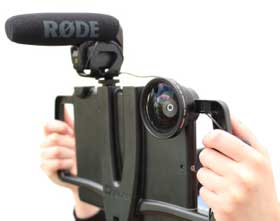
Sample of the iPad case kit Adam bought for his class. Shown are Wide Angle Lens, Direction Microphone, and case with handles and tripod mount.
Because Adam was a beginner filmmaker, his teaching routine was to study the week’s chapter ahead of time and understand the exercise himself right on his iPad. So in class, he went through the chapter’s sections and exercises with his students.
“I like the way the content is broken up into sections, which makes it easy to schedule class time for exercises, while leaving room for out-of-class assigments. So I basically learned about the process and I relayed the information,” he says. “We were all learning.”
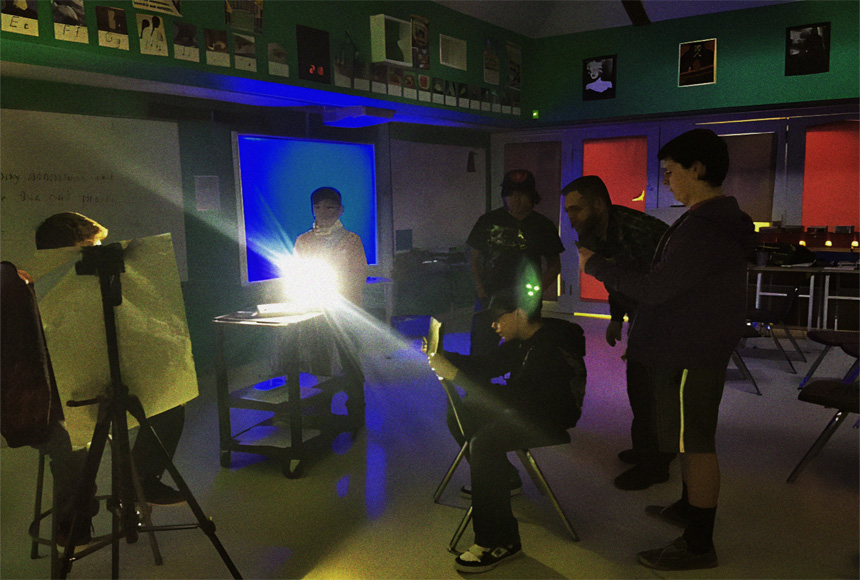
Because he is limited to two hours and forty minutes over two weekly classes, Adam projects the Apple Book’s content – video clips, interviews, galleries, and diagrams onto a large screen through a wired connection.
Additionally, each student is equipped with a copy on their prescribed device. Therefore Adam conducts the chapter’s exercises as a group, while the students may study on their own.
“One of the greatest time-savers was the structured knowledge I was acquiring, which provided me with more educated and informed online searches to get specific information more quickly. “
Project Based Learning with Community Involvement
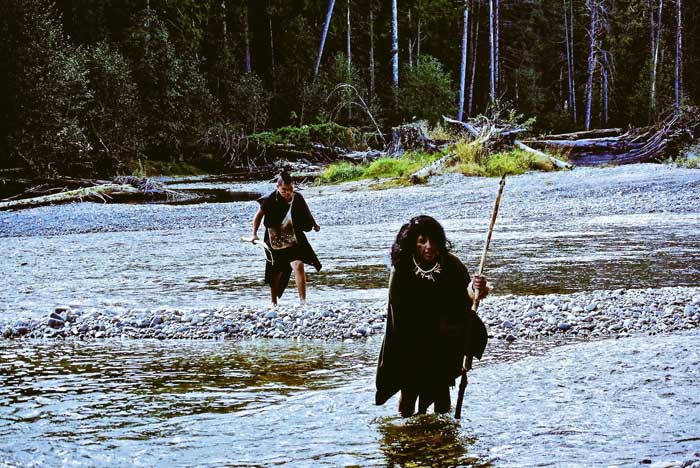
As a First Nations school, its curriculum incorporates Indigenous culture. The common class film project, beyond the basic Cyber Film School exercises, is an ancient legend retold through the lens.

The result was that three months into his program, Adam’s alternative Education film class had not only enhanced the lives of his students but the vibrancy of their entire community as well.
“This is the best example of project-based learning with community involvement I’ve seen.”
Judy Manitowabi, Director Of First Peoples Centre, Canadore College & Nippissing University, North Bay
Consequently, the class recruited community elders including Rocky LaRock as a cultural advisor. He helps with carvings, costumes, props, stories, and legends.
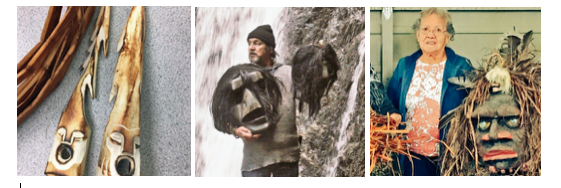
As for other community Elders, they helped with the design and sewing of period costumes and jewelry for the production. Younger children and older adults were recruited as actors. In a community of 450, a dozen teens can impact the entire population.
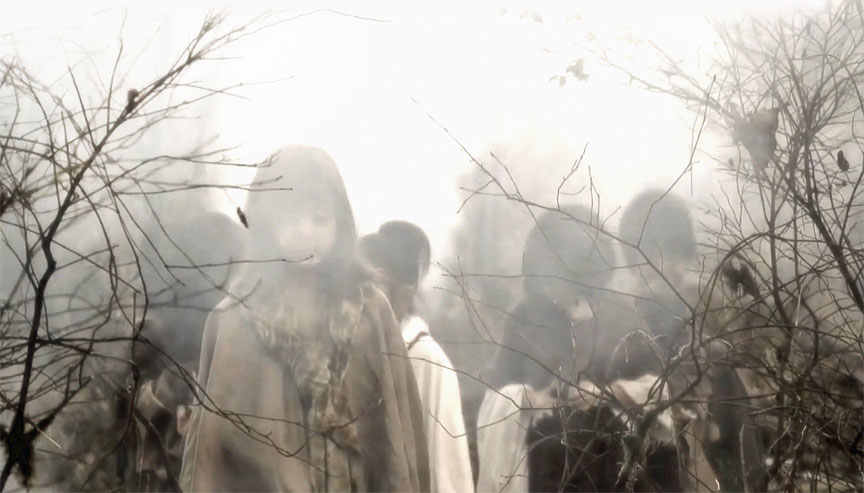
“As for myself, I can only imagine that when bedtime now arrives for these teens, they dream up tomorrow’s adventure then awaken as esteemed storytellers – not only for their community but also as messengers of their culture to the world that surrounds them.”
Stavros Stavrides, Publisher
Diverse Learners
“It’s a unique place”, says Adam. “Everyone comes onto this ‘unequal’ playing field we call the school. For example, Mark, Brian, and I approach Cyber Film School with our varied skills and backgrounds and learn along with these kids.
That makes this alternative education film program a big equalizer. We have kids with good English skills, others with tech skills, and some with people skills. Each contributes their natural ability to support the other in a shared project with a common goal they all relate to.”
“The Book’s multi-touch features are very effective. Our students represent a wide array of learning abilities. We successfully went through Cyber Film School as our main source of theory content in my video class.”
Patty Jenkins, Media Teacher, Parry Sound High School, Ontario
Accordingly, linear and abstract thinkers play off each other. Their individual strengths surface. The technical and the creative cooperate to get it done. And quite importantly, the communication life skills they acquire help bolster their English credit associated with this program.
“That’s how we get this job done”, adds Adam. “In terms of accomplishment and esteem building, I have never seen this anywhere else outside of a sports team. Until now.”
Consequently, as Adam and his students were exploring a cave, Adam stopped to take some personal videos. One of his students jumped in and suggested some camera angles for more effective coverage –” the guy wants to half-bury the camera looking out from the cave, peeking just above the dirt.”
in response, Adam was about to reply to the student, “But this is just my personal video”, but held back the comment. Adam found himself taking direction from his students. Today, his students call the shots.
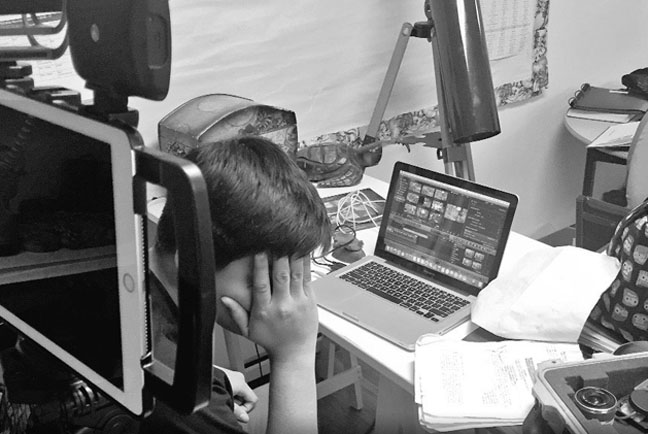
Latest Edition
As for our team and myself back at Cyber Film School, we raced that first Edition of Cyber Film School to market just in time for Adam’s program, to prove the concept.
Then, in June of 2022, we released our much-expanded second edition, with further updates through 2023 based on feedback from the book’s users. And notably, we have optimized the book for iPhone.
Over 200 videos, 700 images, more Hollywood interviews who speak with the beginner in mind, more tutorials, quizzes, and exercises, and an added screenwriting chapter, at the same price as before.
But that’s the business end. What really keeps us going is what our resident teacher/contributor Mary Jane Gomes said to me after witnessing these kids thriving.
“Right now, just seeing those twelve kids dreaming, and creating dreams, makes it all worth while. These young new filmmakers have become our teachers.”
Mary Jane Gomes, Cyber Film School
This is why we do what we do.
Make Cinema Your Language
Cinema is a language we all understand, but not everyone ‘speaks’ it–directors do.
This interactive, self-guided textbook is a director’s toolbox, made for Apple Books.
Embrace a solid foundation with a future-proof, classic combo of theory, technique, history, and critical thinking.
Gain practical, adaptable creative skills and insight that transcend technological changes, be it a camera, mobile device, or AI.




